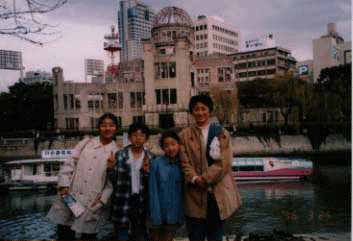
Personality Profile
Junko Imanishi is associate director, Atsumi International Scholarship Foundation.
by VIVIENNE KENRICK
The name of Kajima has for a long time been associated with more than the giant construction and engineering corporation that is one of the largest in the world. Kajima is known too for the signify cant contributions it makes toward benefiting different sectors of society. Junko Imanishi is a Kajima grand daughter who grew up knowing from the inside the processes of philanthropy. She has taken one little niche for her own, where she happily contributes her time, ideas and skills toward helping others.
When she was an 11-year-old, Junko enjoyed a one month stay with children from a dozen countries at the Children's International Summer Village in Ohio. The Japan branch of that organization was presided over by her father, Takeo Atsumi, and is continued by her mother, Itsuko Atsumi. A few years ago, her parents endowed a professorship at Columbia University in New York in order to secure the continuance there of Japanese art. Then, after she was widowed, Junko's mother established the Atsumi International Scholarship Foundation.
Junko, by this time married with four children of her own, began working for the foundation before its inception, and assumed associate directorship on its establishment in 1994. She says that since she was brought up in a public spirited family, she takes it for granted that those who have talent or resources should help others who have less.
The Atsumi International Scholarship Foundation set itself to provide financial assistance to foreign students who have superior academic skills to further their studies at graduate schools in Japan. Junko sees in AISF more than the donation of funds. She reported, "Through monthly social meetings, recreational trips and occasional counseling, AISF tries to keep close communication with the scholarship recipients. The students value human contact and the feeling of being in a world family. They appreciate essential financial help, but it means much more to them if they know friendly faces and warm hearts too."
Junko describes herself as always having ban academically inclined. A Gakushuin graduate in art history, she spent two summers at language courses in Europe, and secured her master's degree in art history and archaeology from Columbia University. "I lived in New York for five years," she said. "I have more experience in the US and Europe than in Asia." AISF has, in turn, bestowed benefit on her. Through it she has found affinity with other Asians.
The first group of AISF scholarship recipients, 24 Ph.D. candidates from nine countries, graduated in March this year. "I think they had all enjoyed our activities, so we established an alumni association in May," Junko said. "We call it the `Raccoon Association' after a logo picture that my father drew. AISF opened its homepage on the internet WWW last year. We were the first scholarship foundation to do this. This year the Raccoon Association opened its home page. It gives very much useful information, directories and addresses. internet and e-mail are so interesting, and such convenient media for students."
Junko is impressed that members of the Raccoon Association, themselves recipient of help, in turn want to help those who follow them. She said, "I see this as a borderless age, and think that foreign students do not have to represent their nations. After getting their Ph.D.s in Japan, they do not have to return to their own countries because they can contribute to societies anywhere in the world. In future, if I have enough money and energy, I would like to establish a scholarship which specifically supports Asian female students."
Junko has one other project that is a long-term one. With Dr. Mary N. Parent she is compiling "The Dictionary of Japanese Architectural and Art Historical Terminology with Japanese Characters." She said, "This is a very ambitious project, already in its 13th year. It has been financially supported since 1985 by Kajima Foundation and Kajima Art Foundation, after receiving one-year grants from the Japan Foundation and Niwano Peace Foundation. It depends heavily also on private contributions. The dictionary is a collaboration of international scholars of Japanese culture. I am working as the head of art history as well as a general organizer, and feel a great responsibility to the foundations and contributors to get the dictionary published by the year 2000."
To Home
All rights reserved, Copyright (c) 1995-1996 Raccoon Association